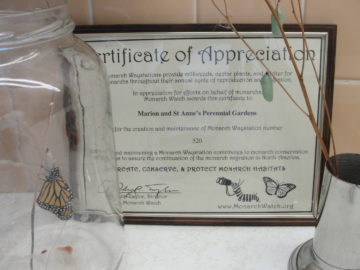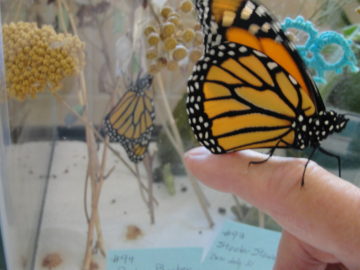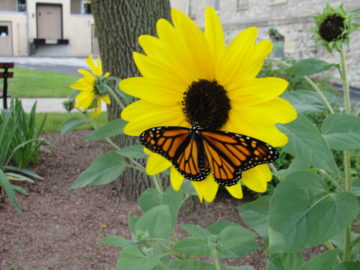For the last 15 years, Franciscan Sisters of Christian Charity have contributed to monarch conservation and continual monarch migration to North America. Sister Caritas Strodthoff writes about the experience.
 Before I got our gardens certified as Butterfly Habitats, I remember reading an article in the local paper about the plight of the monarchs and the decreasing number coming north, putting them on list for possible extinction if numbers continued to plummet Part of the problem was devastation of forest that they over wintered at in Mexico. “Save the Monarch” was a plea from conservationists. I started searching the web for more information and applied for certification when I realize our gardens met all the qualifications with the nearby lake, forestry, and the flowers and plants that could be found here and that we planted in spring/summer.
Before I got our gardens certified as Butterfly Habitats, I remember reading an article in the local paper about the plight of the monarchs and the decreasing number coming north, putting them on list for possible extinction if numbers continued to plummet Part of the problem was devastation of forest that they over wintered at in Mexico. “Save the Monarch” was a plea from conservationists. I started searching the web for more information and applied for certification when I realize our gardens met all the qualifications with the nearby lake, forestry, and the flowers and plants that could be found here and that we planted in spring/summer.
Sister Anne Turba’s brother donated the fish tank that had a screen on top, the perfect “home” for raising caterpillars. The bottom was lined with a piece of paper toweling which helped catch all the “poopies” that results from all that munching. Dried flowers from the garden such as yarrow, the heads of allium, gave caterpillars a place to crawl and hang from to make a chrysalis. Also in the tank was a ceramic bowl with ceramic “frogs” in the bottom to hold milkweed inserted thru saran wrap covering the bowl. Milkweed was changed whenever the caterpillars needed more food. The tank also needed cleaned almost every 1-2 days. Caterpillars attached to the glass walls of the tank, to a favorite branch or gourd, or screen on top, or under a leaf of the milkweed. This was always more difficult when trying to replace old milkweed with new more nourishing leaves.
I’d watch for the spotting of the first monarch in early summer. And then again mid-late July. Sometimes we would get caterpillars early in June but not during the past years. 2020 was a real bumper crop. Every time I looked under milkweed leaf, I’d find a caterpillar. I’ll bring in eggs and most of them would eventually hatch. The tank was located on a shelf in a hallway where Sisters frequently walked on their way to the laundry or when they would come down to the basement on the elevator. Stopping to watch caterpillars munching, waiting for them to transform into a chrysalis, or being amazed when they emerged, and then hung to drip dry. The transformation was always a little miracle…from a teeny tiny baby caterpillar into a large muncher. Then watching them hang down in a “J” formation and suddenly the outer skin splits and the chrysalis forms with its beautiful gold ring. It hardens to a waxy feeling. Two weeks later, one can see the monarch wings taking shape and then the day comes when it suddenly emerges poking its head and wings out first and then its body. It is just so unbelievable seeing this miraculous change…such a sign of God’s fascinating creative mind….and an even more significant sign of the changes that we all go thru from time to time. Transformation, transition…faith in a loving God who takes care of us thru all these radical changes in our lives.
An interesting website that is all about education, conservation and research is Monarch Watch. org. Delving deeper in the site, you will see our monarch waystation in designated as 520 in a listing currently of 35, 123 registered sites. Praise God with us for all creatures great and small.
Began in 2006. Notes beginning in 2011
July, 2011 No monarchs this year
July 2, 2012 13 monarchs so far
August 2, 2013 No caterpillars this year!
August 2, 2014 Only 13 this year.
July 27, 2015 8 caterpillars so far; August 6 Total 17
July 26, 2016: Only 6 caterpillars so far. Found 7 more. Total of 13 this year.
July 18, 2017 26 caterpillars so far; July 26 only 28 caterpillars; August 2: 30 total.
July 2, 2018 7 caterpillars; 14 eggs found today. July 8: 29 caterpillars so far. July 22: 37 caterpillars so far; July 26: 39 caterpillars (lost three) 39 from here plus 20 from Judy
July 8, 2019 Found 3 eggs today! July 19: 50 caterpillars so far. July 22: up to 60 caterpillars; July 26: 65 caterpillars so far. August 3: had 94 caterpillars by this time.
July 8, 2020 Only 6 caterpillars thus far. Slow season this year. July 10: 36 caterpillars s July 19: 84 caterpillars so far!
July 20: 99 caterpillars thus far. July 25: 110 Caterpillars this year
July 6, 2021 Bonnie Jost brought us 21 caterpillars from further north in Wisconsin. Almost all were fully grown and survived.
Next batch from our garden: July 13: 6 caterpillars so far; July 17: 12 caterpillars so far. July 19: up to 29.
August 4 Only 32 caterpillars this year. Hard to find. Lots of eggs but many did not hatch. Only brought in the hatched ones. Might have had more but I doubt it.



Article Comments:
Sr. Sharon Paul, O.S.F. 08/19/2021 @ 11:34 am
Thank you, Sr. Caritas, for all your efforts in “harvesting” & saving butterflies. Thanks for sharing HOW you do this & all your statistics. Amazing! Keep it up!